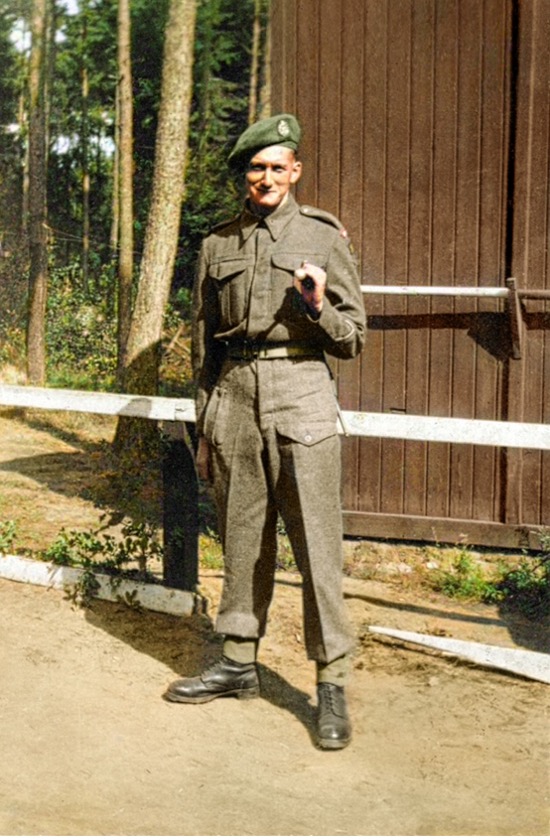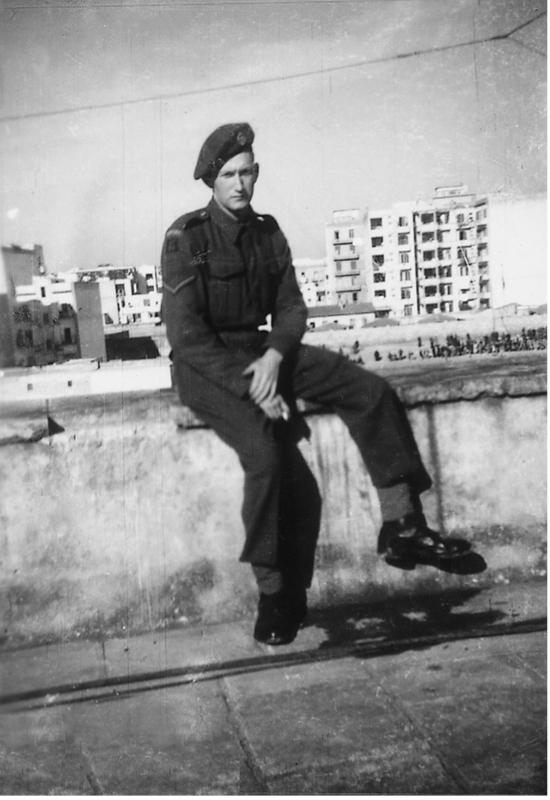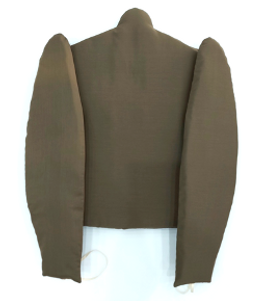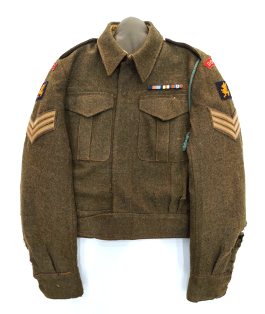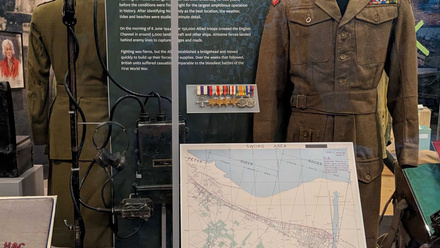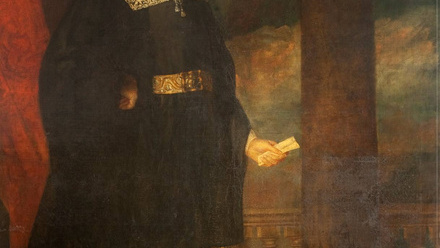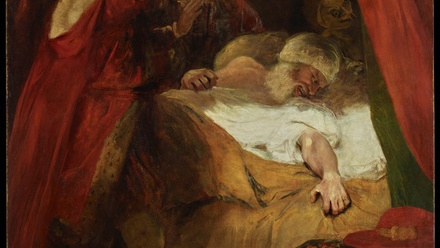The BBC’s Repair Shop show has captured the nation’s imagination, renewing interest in some of the historic items which can be found in homes across the country. But in Icon's series of articles - The REAL Repair Shop - we’re shining a light on the heritage heroes who work diligently and expertly to conserve and protect these treasures
Hundreds of dedicated professionals work in a wide network of conservation studios dotted across the UK and beyond to care for the items that matter most to you - everything from national treasures to family heirlooms and collectables. The conservators working in these specialist studios don’t just make things look good. Conservators take the time to understand the objects they work on and use their professional knowledge to suggest the most appropriate treatment methods to protect your precious objects. And you can find them through our Conservation Register.
In the third post in the series, Roger Pearce talks about getting the military jacket worn by his father in the Second World War conserved. Jamie Robinson, textile conservator at Zenzie Tinker Conservation, reflects on the results of a two-day conservation treatment.
A Military Jacket Returned to Fighting Form
The client: Roger Pearce
If you were lucky enough to grow up inside a wonderful family, as I was, you will no doubt understand that it is difficult to grasp that your parents could actually be subjected to awful life and death experiences in major historical events. At the time it seemed so natural to hear about their experiences during the Second World War that us kids took it for granted, but it didn't really sink in that they were talking about themselves. They were just our wonderful Mum and Dad.
Coming from a small village in South Cambridgeshire made it all the more impossible to link up their recollections to the life we knew. Dad had a box of war memorabilia in the loft that he would go through with us every so often and tell a few more stories, but it didn't really sink in. After he retired we got him to write his stories down to avoid him getting bored, which he did, then to keep him further occupied we suggested he type it into a computer, then to add photos. It was only when we read it that we grasped what he had been through, and how lucky he had been to survive to be the Dad we loved.
He had gone into action as an infantryman just after D Day when he became part of the 4th Dorsets, 43rd Wessex Division. They went on to fight their way through France, Holland and Germany before he ended his service in Italy after the war. One of his luckiest escapes was at the Battle of Arnhem where he went across the Neder Rijn to assist the evacuation of the Airborne forces. Of the 315 men who went across the river only 75 came back.
After he died in 2001 the family published his memories as a book and, remarkably, it started to be seen as a significant historical source of the post D Day campaign as first hand views of these battles were not that common. We got involved with the Dorsetshire Regimental Museum at the Keep Military Museum in Dorchester a while back and they have kindly used extracts of his book in some of their presentations, and we feel we have a strong connection to them.
One of the items we inherited came in a plastic shopping bag. It was his wartime battledress top and it was in a sad state. I remembered that it had lived in the garden shed amongst the pots of paint. It was badly moth eaten and looked like it had been used to wipe a few paint brushes in its time. We couldn’t remember for sure but we deduced that Mum had not let it be kept in the house after it had been moth and insect damaged. It wasn’t seen as anything odd at the time but as we grew to understand the significance of his wartime experiences we started to grasp the importance of the battledress as an artifact.

Battledress jacket before conservation
His sad, paint-stained uniform had been tugging my heart strings every time I saw the plastic bag.
It’s probably the most important piece of family history we have and it was just going to rot away. I just had to do something.
So this is the point that I got in touch with Zenzie Tinker Conservation in Brighton to see if anything could be done. I wasn’t hopeful. Zenzie was able to advise me on a number of options, and after careful consideration I decided to ask them to make it clean and safe to store. The moth and insect damage is extensive so it seemed prudent to take a careful step at a time.
When I opened the box to see the results of the conservation work this week I was delighted. From my earliest childhood memories I had never seen it like this before. The roughness of the cloth makes you feel for the person who had to wear it, let alone fight in it, and the newly cleaned badges and stripes made me think instantly of my Dad standing to attention, chest out, stomach in, and bristling with pride.
Jamie Robinson, textile conservator at Zenzie Tinker Conservation
Before reading Roger’s article I had little understanding of the commemorative significance of the WWII battledress jacket that came to the ZTC studio for treatment in April 2021. I was aware that it had great personal value to the owner and as conservators we try to treat each object with the same reverence regardless of financial value, historic value or sentiment. As a private studio we are lucky enough to conserve everything from christening robes to state beds, however this story has been particularly moving and I now return to the treatment, proud to have played a part in the jacket’s survival.
The jacket was indeed in an excessively poor condition on arrival bearing little resemblance to the garment we could see being so proudly worn in the photos provided by the client. Not only were there paint stains throughout but the holes and areas of loss were so severe that we were led to conclude that it may have been subject to rodent infestation as well as moth. Some of the badges were hanging loose and the cord was fraying and grey with ingrained soiling. The treatment required to individually support the damaged areas would have run into the thousands, an unrealistic cost to the client, but we were determined to do what we could for the garment to stabilise it and make it safe for long-term storage. The paint stains responded well to solvent cleaning tests and it was agreed that with some careful netting the jacket could be made robust enough for commercial dry cleaning. It was therefore sent on an excursion to Upstage Theatrical Dry Cleaners in North London, supervised by Zenzie (together with a number of other objects to reduce the treatment cost to the client).
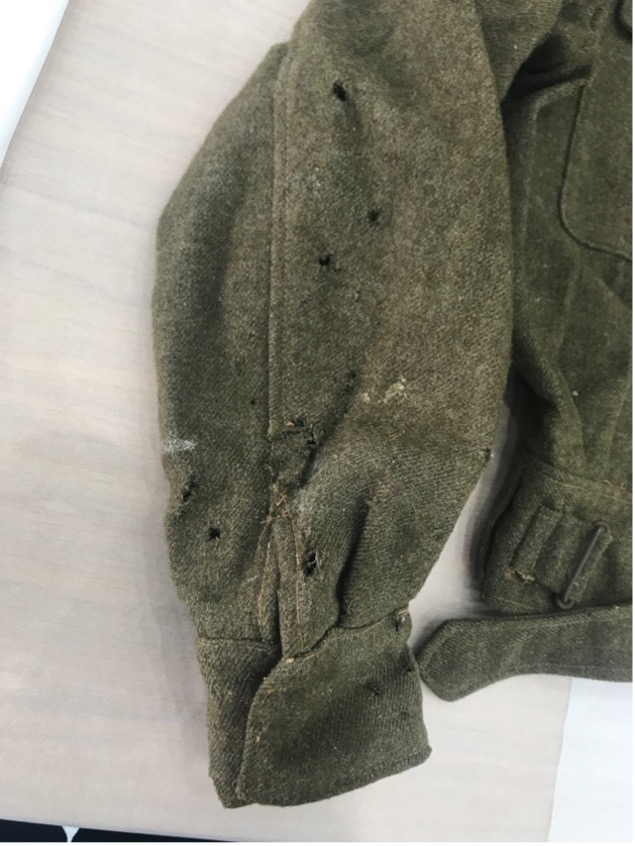
Detail of the right sleeve showing the extent of the paint staining and damage before cleaning
The results were transformative - on the jacket’s return the paint stains had completely disappeared and the garment appeared softer and brighter than we could have anticipated. We were therefore able to focus the remaining 14 hours left in the agreed budget on some very minimal repair patches and netting to the collar (the area most likely to suffer further damage through handling), re-secure the badges and concentrate on the garment’s long-term storage by providing the jacket with a supportive internal mount and box. The mount would both help disguise the rodent damage and provide a shaped form for the fraying fibres to nap to and hopefully prevent worsening of the holes.
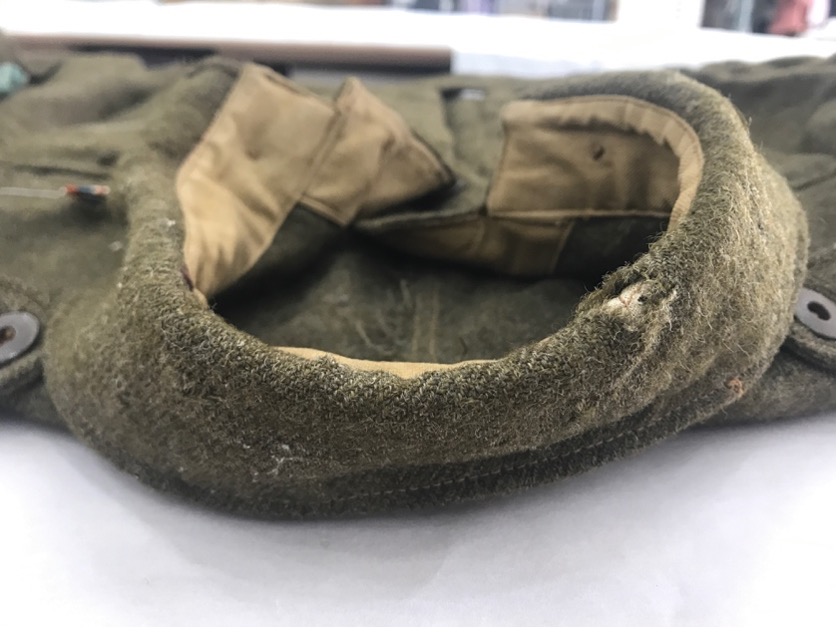
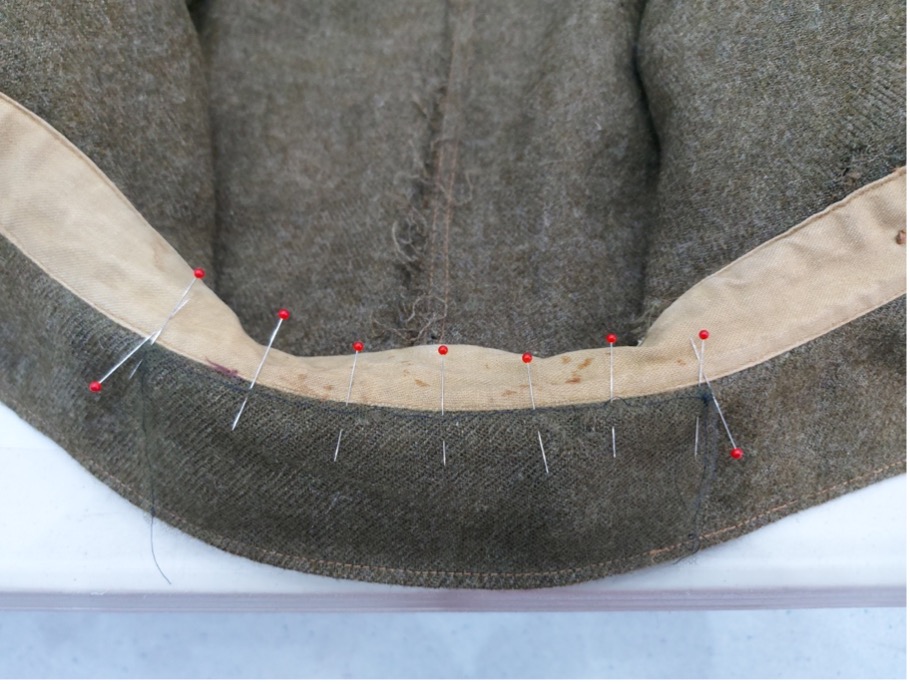
Treating the storage environment rather than the individual areas of damage can be a more holistic approach to a conservation treatment, reducing further damage through protection rather than intervention. We felt confident offering this option as the client was not intending to display or use the garment in any way. We decided on a flat support of polyester wadding for the torso and arms, covered in a pre dyed khaki coloured cotton purchased from a local fabric shop and stripped at the studio. The colour helped to infill the areas of loss while the padded form helped retain the shape and alleviate potential creases from forming through flat storage. A ready-made archival box was purchased from Preservation Equipment and the jacket was carefully packed in acid-free tissue paper for return to the client.
We felt that this was an extremely satisfactory example of how a minimal (two day) conservation treatment can really make a world of difference to an object’s longevity. This rapidly deteriorating jacket had been swiftly turned around into an object that will survive many decades and can now be handed down as a piece of family and social history to generations to come - a tangible reminder to go with Roger Pearce’s father’s story. These very real connections between historic clothing and individual struggles remind us why we become conservators in the first place and it has been a privilege to work on such an ordinary, extraordinary item.

Postscript to the article:
The Pearce family now plan to offer the conserved jacket to the Keep Museum in Dorchester which is the regimental museum of the Dorsetshire Regiment Lance Pearce served with.

